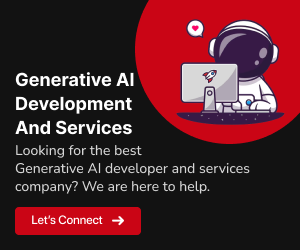Artificial Intelligence (AI) has significantly transformed the way businesses interact with their customers, and one of the most exciting developments in this field is Generative AI. This cutting-edge technology allows computers to generate content, from text to images, in a way that mimics human creativity. In the realm of customer experience, Generative AI is proving to be a game-changer, offering businesses new tools and opportunities to enhance customer interactions, streamline processes, and drive growth. In this blog, we’ll explore Generative AI, its applications, and its impact on customer experience in the United States.
Understanding Generative AI
Generative AI refers to a class of AI models that can generate data that is similar to what they were trained on. These models employ neural networks, which are inspired by the human brain, to create content autonomously. One of the most popular implementations of Generative AI is the GPT-3 (Generative Pre-trained Transformer 3) model, which has gained widespread recognition for its impressive capabilities in generating text-based content.
The core of Generative AI is a deep learning architecture that can learn patterns, context, and semantics from large datasets, enabling it to generate coherent and contextually relevant content. The primary advantage of Generative AI is that it can perform creative tasks, such as writing articles, generating code, or even creating art.
Applications of Generative AI in Customer Experience
Generative AI is redefining the customer experience landscape in several ways:
Personalized Recommendations:
In the highly competitive market of the United States, businesses are constantly seeking ways to stand out and cater to their customers’ unique preferences. Generative AI is instrumental in this endeavor by analyzing user behavior and generating personalized recommendations. Whether it’s suggesting products, content, or services, Generative AI can help businesses provide tailored recommendations that enhance customer engagement and drive sales.
Chatbots and Virtual Assistants:
Chatbots and virtual assistants are becoming increasingly sophisticated, thanks to Generative AI. These AI-powered agents can understand natural language, answer customer queries, and even engage in more complex conversations. In the US, customer support chatbots are now capable of handling routine inquiries, freeing up human agents for more complex issues. This not only reduces response times but also lowers operational costs for businesses.
Content Creation:
Content marketing is a vital component of customer engagement. Generative AI is making content creation easier and more efficient. Businesses can use AI-generated content for social media posts, blog articles, product descriptions, and more. In the United States, this technology has the potential to help businesses maintain a consistent online presence, keep their audience engaged, and save time and resources.
Product Descriptions:
E-commerce companies can utilize Generative AI to efficiently generate product descriptions and reviews. Additionally, this approach not only saves valuable time but also ensures that every product listing is comprehensive, meticulously written, and detailed. Consequently, this enhancement significantly enriches the overall customer experience. It’s a well-established fact that consumers in the United States tend to be more inclined to make purchases when they have access to comprehensive product information.
Market Research:
Generative AI can process vast amounts of data to produce insights and reports, helping businesses understand market trends, customer sentiments, and competitor landscapes. By automating the research process, companies can make data-driven decisions more efficiently, leading to better customer-focused strategies.
Creative Campaigns:
For marketing and advertising, Generative AI can assist in creative campaign development. It can suggest slogans, ad copy, and even generate visuals. This innovative approach can lead to more engaging and eye-catching campaigns that resonate with US audiences.
The Impact of Generative AI on Customer Experience

The integration of Generative AI into the customer experience landscape in the United States has several far-reaching effects:
Improved Efficiency:
Generative AI reduces the time and effort required to create content, answer queries, and generate recommendations. This efficiency translates to faster responses and enhanced customer satisfaction. Here, let’s delve deeper into how this improved efficiency plays out:Rapid Response Times:
With Generative AI-powered chatbots and virtual assistants, businesses can respond to customer queries almost instantaneously. This real-time engagement is crucial in a fast-paced US market where customers demand quick solutions.Enhanced Workflow Optimization:
Generative AI can automate many routine tasks, allowing customer support teams to focus on more complex issues. This not only improves efficiency but also empowers employees to work on tasks that require human expertise.Consistency in Service:
AI consistently adheres to predefined guidelines, ensuring that every customer interaction is in line with company policies. This level of consistency is challenging to achieve with human agents alone.
Enhanced Personalization:
By analyzing customer data, Generative AI can provide highly personalized recommendations and experiences, making customers feel valued and understood. This personalization goes beyond the surface level:Tailored Product Suggestions:
Generative AI can consider a customer’s past purchase history, browsing behavior, and demographic information to recommend products or services that are genuinely relevant to their preferences.Dynamic Content Creation:
It allows for the creation of customized content for customers. For instance, emails, newsletters, and marketing materials can be personalized to cater to an individual’s interests and needs.Adaptive Customer Journeys:
With Generative AI, businesses can adapt their customer journey flows based on user interactions. This means that each customer’s experience is unique, fostering a sense of individual attention and care.
24/7 Availability:
Chatbots powered by Generative AI can operate round the clock, ensuring that customer inquiries are addressed even outside of traditional business hours. This continuous availability is a significant asset in a market like the US, where customers have diverse schedules and expect service at their convenience.Global Reach:
With customers from various time zones and locations, Generative AI ensures that businesses can cater to a worldwide audience efficiently, transcending geographical barriers.Handling Peak Loads:
Indeed, during peak hours, such as product launches or holiday sales, AI-powered chatbots excel at handling a surge in customer inquiries, effortlessly managing the increased workload without necessitating additional human resources. This scalability not only ensures the efficient management of high demand but also presents a cost-effective solution for businesses.
Cost Savings:
Reduced manpower requirements for routine tasks and the ability to streamline content creation lead to significant cost savings for businesses. Here are some key points underpinning these cost savings:Labor Cost Reduction:
The automation of routine tasks minimizes the need for extensive customer support and content creation teams. Businesses can allocate resources more effectively.Minimal Training Costs:
Training AI models generally incurs a one-time expense, whereas training human employees involves ongoing costs. Generative AI reduces the burden of training and onboarding.Error Reduction:
Generative AI operates with precision and consistency, reducing the chances of costly errors in customer interactions and content creation.
Competitive Advantage:
Businesses that adopt Generative AI early gain a competitive edge by offering superior customer experiences, driving customer loyalty, and attracting new clients. Here’s how this advantage can be harnessed effectively:Brand Differentiation:
Companies that leverage Generative AI can position themselves as innovators in their respective industries, which can lead to increased customer trust and loyalty.Improved Customer Retention:
Enhanced personalization and efficient service contribute to higher customer satisfaction and retention rates, reducing customer churn and boosting revenue.Attraction of New Customers:
A reputation for exceptional customer experiences draws in new customers who are seeking a seamless and personalized engagement.
Also Read: “Exploring the Power of Generative AI: What Is It and Why Is It So Popular? How Can You Use It?“
Ethical Considerations
While Generative AI offers numerous benefits, it also raises ethical concerns, especially regarding the generation of fake content, misinformation, and privacy issues. Businesses must use this technology responsibly, respecting the privacy and trust of their customers.
Generation of Fake Content:
Generative AI can create content that is remarkably convincing, blurring the lines between human-generated and AI-generated material. This ability has raised concerns about the potential for malicious actors to exploit this technology for unethical purposes. Businesses and society at large must be vigilant about:Misinformation:
There exists a risk that AI-generated content, encompassing fake news, reviews, or social media posts, might be employed to deceive individuals, manipulate public opinion, or tarnish reputations.Deepfakes:
Generative AI can create convincing audio and video content, giving rise to deepfake technology. This technology can be used to create forged videos and audio recordings that could have serious legal and reputational implications. Forgery:
Documents and visual content generated by AI may be used for fraudulent purposes, such as creating counterfeit documents, IDs, or art.
Privacy Concerns:
The use of Generative AI often relies on the analysis of large datasets, which may include personal information. Businesses must be vigilant in safeguarding the privacy of their customers:Data Protection:
The collection and analysis of customer data for personalizing experiences should be undertaken responsibly, aligning with data protection laws, such as GDPR in the EU or CCPA in California.Informed Consent:
Companies should ensure that customers are fully aware of how their data is used and provide them with the option to opt in or out of personalized services.Data Security:
Robust cybersecurity measures must be in place to protect customer data from potential breaches. Mishandling data could lead to serious privacy violations and legal consequences.
Bias and Fairness:
Generative AI models are trained on large datasets, which can contain biases present in the data. If not properly addressed, this can lead to AI-generated content that reflects or amplifies societal biases, whether they’re related to gender, race, or other factors:Fairness and Inclusivity:
To ensure fair treatment of all customers, businesses should actively work on minimizing biases within AI models and data, and consider diversity, equity, and inclusion principles in their AI development processes.Transparency:
Transparency in AI operations is essential to understand how AI-generated content is created and why certain recommendations are made. Providing customers with insights into the AI’s decision-making process helps build trust.
Job Displacement and Economic Impact:
The automation of tasks by Generative AI can lead to workforce disruptions. Businesses must consider the implications of AI adoption on their employees and local economies:Reskilling and Workforce Transition:
Companies should invest in training and reskilling programs to help employees adapt to new roles as AI takes over routine tasks. This demonstrates a commitment to employee well-being and societal responsibility.Economic Equity:
Widespread AI adoption may have an impact on employment in certain industries. Policymakers and business leaders should work to ensure that AI adoption benefits society as a whole and doesn’t exacerbate economic disparities.
Conclusion
In conclusion, Generative AI is revolutionizing customer experience in the United States. With applications ranging from personalized recommendations to content creation and market research, businesses are better equipped to serve their customers in an increasingly competitive market. As this technology continues to evolve, it will be fascinating to see how it shapes the future of customer interactions and drives innovation in the business landscape. As the field of Generative AI continues to develop, it’s crucial for businesses to stay updated with the latest advancements and leverage this powerful tool to create exceptional customer experiences.


























Add Comment